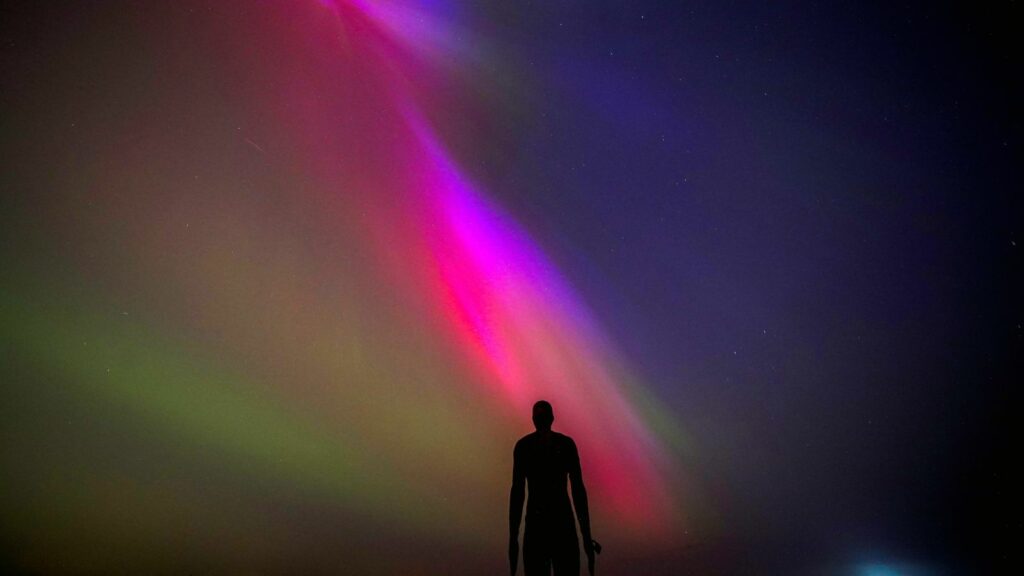Northern Lights could be visible in the UK again in a matter of weeks | Science & Tech News

The Northern Lights could light up our skies again as early as next month.
Skies over the UK turned pink and green last weekend as the Northern Lights produced incredible displays for skygazers.
The spectacle came after the National Oceanic and Atmospheric Administration (NOAA) in the US issued its first severe solar storm warning since 2005 as a huge geomagnetic storm raced towards Earth.
“We had a quite enormous sunspot, about 15 times the size of the Earth, on the Earth-facing side of the sun,” Krista Hammond, a space weather expert at the Met Office, said.
“It was releasing a lot of solar flares and coronal mass ejections which are enormous eruptions of charged particles.
A number of the eruptions caught up with each other, which meant that by the time they arrived on Earth, the resulting geomagnetic storm was much stronger than any of the individual eruptions would have caused in isolation.
“The last time we saw a geomagnetic storm of this magnitude was back in 2003,” Ms Hammond said.
The sun is in the most active period of its 11-year cycle, which means we could get another chance to see the Northern lights in the next few weeks.
“The sunspot region, which gave all the solar flares and the coronal mass ejections, is now rotated round to the other side of the sun which isn’t facing the Earth,” Ms Hammond said.
“But in a couple of weeks’ time, that area will start to rotate back around to face the Earth again.”
The lights, or aurora borealis, appear in the sky when electrically charged particles from the sun travel across space and collide with Earth’s atmosphere.
Northern Lights from High Wycombe
Most of these particles are deflected away, but some become captured in our magnetic field, accelerating towards the north and south poles.
This is why we usually see the lights near the magnetic poles. Occasionally, however, solar storms are powerful enough to make them visible further away from the poles.

Northern Lights from Edinburgh
When the sun is at its least active in its 11-year cycle, a period known as “solar minimum”, we observe about one of these ejections a week. At the current point in the cycle, the “solar maximum”, we see an average of two to three per day.
For a huge, visible display such as last weekend’s, a number of factors need to coincide, according to Ms Hammond.
The sun must fire out multiple ejections in the direction of Earth, the storm they cause has to be big enough to be visible in the UK, it has to arrive at night and there has to be clear skies so we can actually see the display.

Northern Lights from Hazlemere, Bucks. Pic: Dev
“The sun has to throw out the Coronal Mass Ejections and in the direction of Earth. But like throwing a six, the occurrence of one doesn’t change the chance of another,” Professor Mike Lockwood, president of the Royal Astronomical Society, said.
The sun takes about 27 days to spin on its axis, which could mean we see another display from the same area of the sun at the beginning of June.
Read more from Sky News:
The best pictures as Northern Lights glow up skies across UK
‘Wall of death’ workout could keep moon settlers in shape
Giant sun explosions could help NASA find out how to live on Mars
The solar activity does cause problems here on Earth, particularly in systems reliant on satellites.
Elon Musk’s Starlink satellites, which provide internet connections in remote areas, were “under a lot of pressure” during last week’s solar storm, he claimed on X.

Northern Lights from High Wycombe
Tractor maker John Deere warned customers its GPS systems were “extremely compromised” by the storm.
And some parts of New Zealand’s national electricity grid were switched off to “prevent damage to equipment”, according to the provider.

Keep up with all the latest news from the UK and around the world by following Sky News
Tap here
Ms Hammond suggested that last weekend’s display was “quite an unusual situation”.
However, many people keen to get a glimpse of the magnificent Northern Lights could still be in luck.
Recent Posts
- Shaping Jordan’s Culinary Future Through Youth Empowerment
- Bratislava and Vilnius rank as cheapest Christmas market destinations
- Maximizing Share of Voice and Prioritizing Direct Bookings: A Strategic Guide for Hotels
- Aldar Adds to Saadiyat Cultural District’s Exceptional Luxury Living with Launch of Mandarin Oriental Residences
- Tributes paid to ‘wonderful ambassador’ Nan Short






Recent Comments